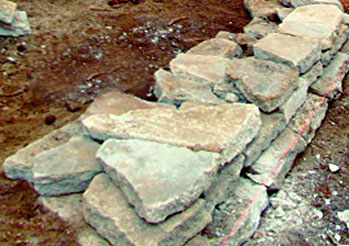Constructing a Dry Stone Wall
Basic Structure
Essentially, a dry stone wall consists of two parallel walls that are built closer together as the wall increases in height until they are actually touching at the top. Long pieces of stone are incorporated to tie the two walls together at strategic points (variously referred to as tie stones or bonding stones) and heavy capstones that span across the width of both walls at the top help to keep everything locked together by their weight.
Good appearance does not necessarily indicate good workmanship. Much of the strength of a dry stone wall depends on the internal structure that is not visible in the finished wall. Consequently, poor workmanship where it is unseen can result in early failure of the wall. This can often happen within the first few years, whereas a wall that is well built throughout its structure can be expected to last for a century or more with only a minimum of maintenance.
Sound Foundation
Strong foundations are essential for long life. This requires that the ground be as firm as it is possible to make it since settlement will cause movement throughout the wall structure, resulting in weaknesses developing.
This is an aspect that requires particular care if you are repairing or rebuilding an existing wall. If there are signs of uneven settlement in the foundation, it is vital that this weakness is rectified for a lasting repair to the wall.
Assuming the land on which you intend to build the wall is reasonably stable, dig a shallow trench where the wall is to be built and ensure the soil at the bottom is well compacted. This trench needs to be as wide as the base of the finished wall and sufficiently deep to take a foundation layer of sand about four inches thick, along with the lowest level of bonding stones.
If there are any doubts about the natural stability of the land, you must remedy this before starting to build since, if it cannot withstand the weight of the stone, the finished wall will inevitably be unstable.

If the land is waterlogged or boggy, it may be that it is totally unsuitable and you will need to abandon the idea of a dry stone wall in that location. Otherwise, you may be able to compensate by using a six inch layer of concrete in place of the sand. If this latter course is taken, then make the foundation trench a few inches wider on either side of the wall.
Place a bonding stone at either end of the trench and additional stones at intervals along its length. The exact spacing is not critical but is typically three or four feet. Fill the space between the bonding stones with smaller stones or pebbles that are roughly the same thickness as the bonding stones and ensure these are well bedded in.
The aim is to achieve a foundation layer of stones that are reasonably level, though because you are using natural materials, this is never going to be perfect. Nevertheless, this should always be your aim.
Read more about Dry Stone Walling |
Read about more Gardening Techniques |
